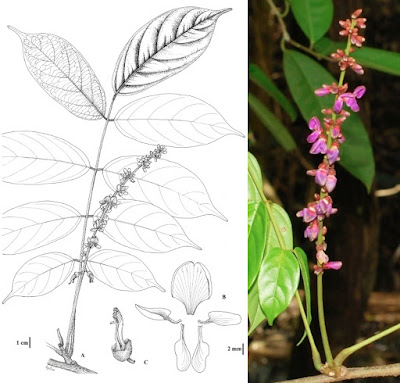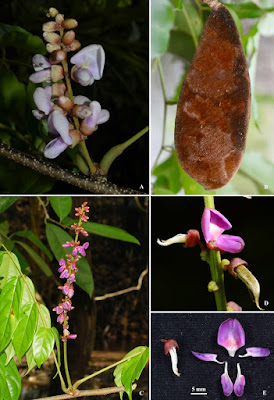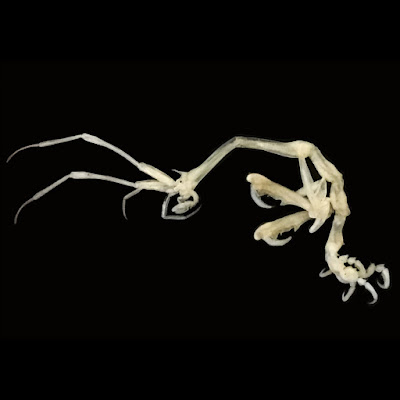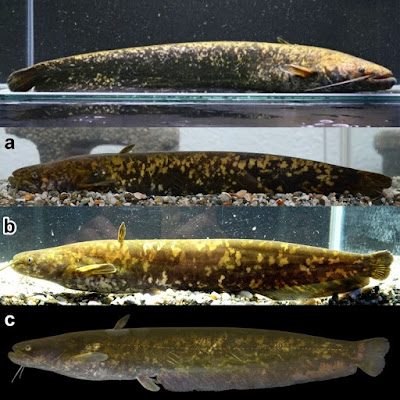[Most Recent Entries] [Calendar View]
Wednesday, October 16th, 2019
| Time | Event | ||||
| 10:43a | [Botany • 2019] Millettia phuwuaensis, M. pyrrhocarpa & M. suddeei • Three New Species, Lectotypifications and Synonymisations in Millettia (Fabaceae: Faboideae) for Thailand ABSTRACT During preparation of the account of the genus Millettia (Fabaceae: Faboideae) for the Flora of Thailand, some new field collections and specimens from herbaria were found to represent three new species, and here they are described and illustrated with a distribution map. Lectotypes of Millettia names are designated for nine species, five new synonyms of Millettia are proposed and Millettia tecta is raised to species status. KEYWORDS: Generic circumscription, Leguminosae, Millettieae, taxonomy Millettia phuwuaensis Mattapha & Suddee, sp. nov. This species is similar to Millettia penicillata Gagnep. in having distinct red lines on the outer surface of the standard, but differs in its fewer leaflets (5–7 vs 9–17 in M. penicillata), shorter pseudoracemesor pseudopanicles (up to 10 cm long vs 8–28 cm in M. penicillata), monadelphous stamens (vs diadelphous stamens in M. penicillata) and a tubular disk (vs disk absent in M. penicillata). Vernacular.— Phan na rai phu wua (พรรณรายภูวัว). Etymology.— The specific epithet refers to the type locality. Notes.— Millettia phuwuaensis has distinctive red lines and dense puberulent hairs on the outer surface of the standard. The reddish lines look super-ficially similar to those of M. penicillata but are thicker and more unevenly scattered (vs parallel in M. penicillata). Additionally, Millettia phuwuaensisis recognised by its narrowly obovate and larger standard petal (14–15 × 12–13 mm vs orbicular and 8–9 × 9–10 mm in M. penicillata). Millettia pyrrhocarpa Mattapha, Forest & Hawkins, sp. nov. This species is similar to Millettia sericea (Vent.) Wight & Arn. ex Hassk., in having ferruginous hairs on the exocarp surface of the fruits, but differs in its caudate leaflet apices (rather than the acute or retuse apices in M. sericea). The lower leaf surface is densely hairy along the midrib, but otherwise glabrous (vs densely sericeous throughtout in M. sericea), the standard petal has basal callosities tapering into the claw (vs basal callosities absent in M. sericea), and brachyblasts carry ca 3 flowers (vs 10 or more in M. sericea). Vernacular.— Nang rong (นางรอง). Etymology.— The specific epithet refers to the densely ferruginous hairy fruits. Notes.— Millettia pyrrhocarpa was collected in the same locality by different collectors, but has remained unrecognised as a new species. We found it amongst unidentified collections with other unnamedMillettia specimens, therefore, only when we had identified flowering and fruiting material could we confirm that it was a new species based on the standard having basal callosities tapering into the claw, presenceof ca 3 flowers on the brachyblasts and the fruits covered with densely ferruginous hairs. Because of the ferruginous indumentum on the fruits, the species was compared with the most similar species, M. sericea. It differs from M. sericea in its smaller and thinner leaflets lacking sericeous hairs on the lower surface, and smaller standard petals (8–9 × 8–9 mm vs 10–13 × 10–12 mm in M. sericea), lacking sericeous hairs on their outer surface (vs densely sericeous in M. sericea).
This species resembles Millettia puerarioides Prain, but differs in having stipels (stipels absent in M. puerarioides), sparsely pubescent hairs on the lower surface of the leaflets (vs densely silky hairs in M. puerarioides), and diadelphous stamens (vs monadelphous in M. puerarioides). It is also characterized by having 7–9 leaflets (vs 5–7 in M. puerarioides), and a standard petal with pubescent hairs on the outer surface (vs densely silky hairs in M. puerarioides). Vernacular.— Phi lai somran (พิไลสมราน). Etymology.— The epithet refers to Dr. Somran Suddee, who first collected the species. Sawai Mattapha, Felix Forest, Julie A. Hawkins, Somran Suddee, Naiyana Tetsana and Pranom Chantaranothai. 2019. Three New Species, Lectotypifications and Synonymisations in Millettia (Fabaceae: Faboideae) for Thailand. THAI FOREST BULL., BOT. 47(2); 171–183. DOI: 10.20531/tfb.2019.47.2.07 | ||||
| 1:36p | [Crustacea • 2019] Confirmation of Caprella scauroides Mayer, 1903 (Crustacea: Amphipoda) from New Zealand, using Integrative Techniques
Abstract The presence of caprellid amphipod, Caprella scauroides is confirmed for the first time from New Zealand waters through two separate sample submissions received by the Ministry for Primary Industries (MPI) Marine Invasives Taxonomic Service (MITS) during May 2017, both from Ōkahu Bay, Waitematā Harbour, from swing mooring ropes. A subsequent report (November 2017) recorded the species from the Whāngārei Harbour Marine High Risk Site Surveillance (MHRSS) survey. Caprella scauroides, non-indigenous to New Zealand, is morphologically similar and closely related to the known invasive, Caprella californica, with which it is often confused. Caprella scauroides from New Zealand is described in detail using both morphological and molecular methods. Keywords: Crustacea, Invasive, introduced, morphology, molecular, Caprellidae Rachael A. Peart, Chris M.C. Woods, Judy E. Sutherland and Serena L. Cox. 2019. Confirmation of Caprella scauroides Mayer, 1903 (Crustacea: Amphipoda) from New Zealand, using Integrative Techniques. Zootaxa. 4686(3); 361–375. DOI: 10.11646/zootaxa.4686.3.3 | ||||
| 2:19p | [Ichthyology • 2018] Silurus tomodai • A New Catfish (Siluriformes: Siluridae) from central Japan
Abstract A new catfish, Silurus tomodai, is described based on 37 specimens; 132-514 mm > 139-514 mm [132–514 mm standard length (SL)] collected from streams of Mie, Aichi, Gifu, Shizuoka and Nagano prefectures of central Honshu Island, Japan. Although S. tomodai is closely related to S. lithophilus (Tomoda, 1961) based on partial mitochondrial DNA sequences, the former can be distinguished from the latter by the position of dorsal fin (predorsal-fin length 28.5–32.1% vs. 30.1–33.7% SL), a shorter head (18.5–21.2% vs. 19.5–22.2% SL) that is more broadly rounded in ventral view, a more slender body (depth at 10th anal-fin ray 12.9–18.3% vs. 15.7–18.8% SL, and 86.8–100.3% vs. 97.2–109.7% of body depth at anal-fin origin), longer mandibular barbel [20.4–47.7% vs. 10.7–35.3% of head length (HL)], shorter anal-fin rays (10th anal-fin ray length 32.2–38.3% vs. 37.3–45.3% HL), eye slightly protruding laterally beyond profile in dorsal view, and the shape of medial depression on anterior face of mesethmoid (deep and narrow vs. shallow and wide). Silurus tomodai differs from S. asotus, a species widely distributed in Japan including central Honshu Island, in the shape of vomerine-tooth band (typically separated into two distinct lenticular patches vs. continuous), the shape and size of teeth (small and slightly recurved vs. relatively large and recurved), snout length (34.7–38.9% vs. 33.0–36.5% HL), the length of lower jaw (110–124% vs. 124–138% of snout length), interorbital width (53.0–61.3% vs. 46.3–52.8% HL), eye location (vertical through anterior margin of pupil usually posterior vs. anterior terminus of lips), inter-mandibular barbel width (24.7–32.5% vs. 21.7–26.7% HL), vertebral count (62–65 vs. 58–63), pigmentation on underside of head (usually mottled with dark pigmentation vs. uniformly white, rarely dark with pale band along posteroventral margin of lower jaw) and eggs yellow (vs. light green). Keywords: Pisces, Siluridae, Silurus tomodai, Silurus lithophilus, cryptic species diversity, Japan
Silurus tomodai Hibino & Tabata, 2018, sp. nov. New Japanese name: Tanigawa-namazu; new English name: Tomoda’s Catfish Etymology. The scientific name tomodai honors Dr. Yoshio Tomoda, the author of “Two New Catfishes of the Genus Parasilurus found in Lake Biwa-ko” (1961). The Japanese standard name, Tanigawa-namazu, refers to the mountain stream (means "Tanigawa" in Japanese) habitat of S. tomodai. Yusuke Hibino and Ryoichi Tabata. 2018. Description of A New Catfish, Silurus tomodai (Siluriformes: Siluridae) from central Japan. Zootaxa. 4459(3); 507–524. DOI: 10.11646/zootaxa.4459.3.5 |
| << Previous Day |
2019/10/16 [Calendar] |
Next Day >> |










